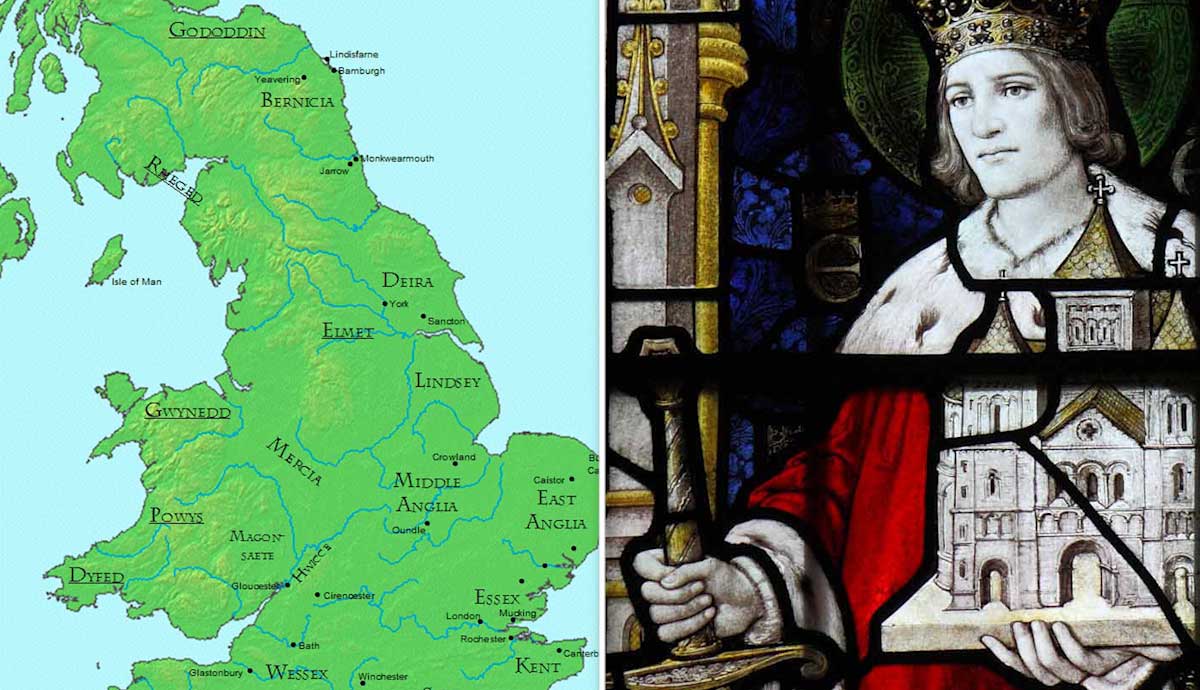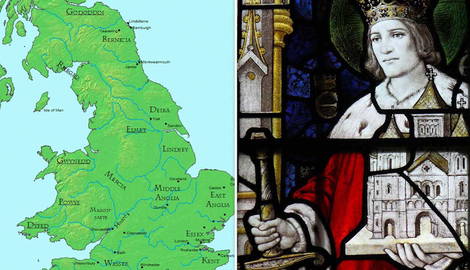
During early Dark Age Britain, the Britons and the Anglo-Saxons were chronically at war with each other. This warfare started around 430 and continued over the centuries that followed. Already by the first half of the 7th century, the Anglo-Saxons had clearly gained supremacy over the island, controlling the majority of what is now England.
Warfare between the two groups did not stop there, however. Yet, despite this centuries-long conflict, the Britons and the Anglo-Saxons were not permanent enemies. Something that has pervaded the study of this period is the idea that all the Anglo-Saxons were united against all the Britons. The reality, as is so often the case, is more complicated than that.
Was Cerdic of Wessex a Brythonic Ally of the Anglo-Saxons?

Firstly, let us clarify an issue that often comes up in the context of this subject. One of the most prominent leaders of the Anglo-Saxons in the 6th century is Cerdic of Wessex. He is famous for being the founder of Wessex, one of the most important kingdoms of England. A variety of English documents speak of him, including chronicles and genealogies. It has been widely recognized that his name is Brythonic, a later form of the same name used by the famous Caratacus who fought against the Romans in the 1st century CE. Some of Cerdic’s near descendants also seemingly had Brythonic names. On this basis, many researchers have claimed that he was actually a Brythonic leader fighting on the side of the Anglo-Saxons.
While this possibility cannot be completely discounted, it is not supported by any evidence beyond these names. The Anglo-Saxon Chronicle does not describe him as spreading out from British territory that he already held. The Anglo-Saxon genealogical records also provide him with a Germanic ancestry, and most of his descendants have Germanic names. In all likelihood, Cerdic had a Brythonic name due to his mother or grandmother, who could easily have been captives, being Brythonic.
The Alliance at Catraeth

A famous and important poem from this period is the Y Goddodin, usually thought to have been composed and set around the year 600. This text describes a disastrous military expedition by a Brythonic army against Catraeth, a location near the border of England and Scotland. It is usually identified with Catterick in North Yorkshire. According to the traditional translation and interpretation of this poem, this was a straightforward battle between the Britons and the Anglo-Saxons.
The Britons were principally the Gododdin, a tribe descended from the Votadini of the Roman era. It appears that they lived approximately in the region between Edinburgh and Hadrian’s Wall. There are also some references to supporting troops of Britons from elsewhere. The opposing side in this war is generally held to have been made up of the Angles from the kingdoms of Bernicia and Deira.

However, this is not the only interpretation. Some recent scholarship, principally argued by John T Koch, suggests that this was actually a war between Britons and other Britons, fought along with Anglian allies. In large part, this argument is based on identifying the conflict described in Y Goddodin with a battle described in a different poem, Gweith Gwen Ystrat.
This latter poem concerns the activities of Urien Rheged, a king active in Yorkshire who is normally considered to have been dead by the time the events of Y Goddodin occurred. Koch interprets this latter poem about Urien to be the victor’s version of the same event described in Y Goddodin. On this basis, by comparing the two poems, Koch concludes that Urien was allied with the Angles of the kingdom of Deira. With them, Urien fought against the Goddodin.
Despite the weight of John T Koch’s authority, many other scholars have criticized this interpretation. The supposed evidence that both poems are referring to the same event is not particularly strong, in the opinions of some other scholars.
A Religious Alliance

However, there is one piece of evidence that Koch uses in support of his argument concerning Y Goddodin which stands on its own merit. This is a fact recorded in the Historia Brittonum, a British record written in Latin regarding this era. Notice the following claim:
“The following Easter, Edwin himself received baptism, and twelve thousand of his subjects with him. If any one wishes to know who baptized them, it was Rum map Urbgen.”
The Edwin mentioned here is the historical figure often called King Edwin of Northumbria. He was actually the king of Deira and Bernicia. The “Rum map Urbgen” mentioned at the end is Rhun the son of Urien Rheged. Thus, according to this record, the son of Urien was the person who baptized King Edwin and his subjects. This was not the case of an isolated religious figure from British territory going over to enemy territory. Rhun was a royal prince, the son of powerful King Urien. Although this does not necessarily mean that there was any kind of military alliance between the two kingdoms, nonetheless, it does indicate a notable degree of cooperation in at least some areas.
The Major Alliance of the 7th Century

The most significant alliance between these two ethnic groups (as well as the best documented one), occurred between the 630s and the 650s. During this tumultuous period, Northumbria was growing in power. It was the amalgamation of the kingdoms of Bernicia and Deira. The kings of this kingdom were attempting to expand their power so much that they even posed a threat to other Anglo-Saxon kingdoms. Mercia was another powerful kingdom, but Penda, its king, was so concerned by the Northumbrian threat that he agreed to an alliance with the Britons.
This was a massive alliance that was so notable that it was mentioned in a variety of different historical records from this era. The Historia Brittonum, for example, mentions “the kings of the Britons who went out with Penda” on a military expedition. It appears that Penda was the most powerful king in this alliance. According to another statement in the Historia Brittonum, this alliance was with “the kings of the Britons,” meaning that a variety of Brythonic kingdoms were involved.

At least one other Anglo-Saxon kingdom was involved in this alliance. This was the kingdom of Deira, under the rulership of Athelwald, the nephew of Oswiu of Northumbria. After Penda, he seems to have been the most powerful Anglo-Saxon king of this grand alliance. This alliance and Athelwald in particular, appear in the Book of Llandaff, a 12th-century record of land grants to the church.
Before one particular entry, the text explains that the border regions of Wales were attacked by the Saxons, particularly in the southeast. It then explains that after peace was established again, and land was restored to its rightful owners, “an alliance of the Britons formed in those parts.” This would appear to be the alliance of “the kings of the Britons” implied by the Historia Brittonum when they went out with Penda.
This account is set in the time of “Telpaldus and Ithailus, kings of Britain.” The latter is Ithael son of Morgan, a mid-7th century king of Glamorgan and Gwent. The former, Telpaldus, appears to be a garbled form of “Athelwald,” the most prominent Anglo-Saxon king after Penda. Likely, Penda was not mentioned here in this church record because he was a pagan king.

This momentous alliance also appears in medieval Welsh poetry. One example is a poem written in honor of Cynddylan son of Cyndrwyn, a prince of the Welsh kingdom of Powys. It may well date from the 7th century. This poem refers to Cynddylan heading out into battle with 700 warriors “when the son of Pyd desired.” The son of Pyd is certainly Penda, whose father Pybba is called “Pyd” in Welsh texts.
There is very little evidence regarding the other kings of the Britons involved in this alliance. The Historia Brittonum refers to the kings of the Britons going out with Penda and dying in battle with him. Penda died in 656, yet the only king of the Britons whom we know was an ally of Penda and may have died then is Cynddylan. He could have died in that year, but there is no confirmation of this. In any case, the Historia Brittonum uses the plural, so there must have been others about whom there is no surviving record. It is also a virtual certainty that King Ithel, son of Morgan of Glamorgan and Gwent, was also involved in this alliance, going by the account in the Book of Llandaff. Yet, he too, did not die until much later.
The Alliances of the Britons With the Anglo-Saxons

In summary, we can see that there are very few recorded alliances between the Britons and the Anglo-Saxons, but they did sometimes happen. One possible early example is Cerdic of Wessex, who is speculated by many to have been a Brythonic leader working for the Anglo-Saxons. In reality, there is little evidence in support of this.
A more convincing proposition is that the kingdom of Rheged was allied in some way with the Anglian kingdom of Deira. While John T Koch’s interpretation of Y Gododdin as referring to an alliance of Urien with Deira has been criticized, there is other evidence for this connection. The fact that Rhun, the son of Urien, is reported to have baptized the king of Deira and his subjects may well be significant.
By far the most famous, significant, and well-documented alliance between the Britons and the Anglo-Saxons in the early Dark Ages occurred in the 630s to the 650s. This alliance was headed by Penda, the powerful king of Mercia. It also involved Athelwald of Deira, apparently the Telpaldus of the Book of Llandaff, as well as the kings of Gwynedd, Powys, and Glamorgan, along with others.










